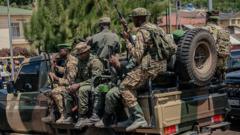Can Rwanda and DR Congo Finally Achieve Lasting Peace with New Draft Deal?

Prospects for Peace: Understanding the Rwanda-DR Congo Draft Agreement
In a significant development, representatives from Rwanda and the Democratic Republic of Congo (DRC) have reached a draft agreement that has the potential to bring an end to decades of conflict in the region. This landmark achievement, mediated by the United States and Qatar, outlines critical measures aimed at fostering peace, security, and economic cooperation. This article delves into the details of the agreement, its historical context, the implications for the region, and what questions still remain unanswered.
The Context of Conflict
The eastern region of the Democratic Republic of Congo has been marred by conflict for over three decades, with various armed groups vying for control of its rich mineral resources. The ongoing strife has resulted in massive loss of life, displacement of civilians, and a humanitarian crisis that continues to unfold. At the heart of this turmoil is the M23 rebel group, which has been accused of having backing from Rwanda and has recently seized control of significant territories, including Goma and Bukavu.
A Brief History of Rwanda-DR Congo Relations
The relationship between Rwanda and the DRC has been historically tumultuous, with roots tracing back to the 1994 Rwandan genocide. Thousands of Hutus fled into eastern Congo, where they formed armed groups, including the FDLR, which are linked to the events of the genocide. The DRC has faced numerous incursions from Rwandan forces over the years, leading to a cycle of violence that has repeatedly destabilized the region.
The Role of External Mediators
The current draft agreement is the result of extensive mediation by the United States and Qatar. Following three days of "constructive dialogue," officials from both countries met in Washington to discuss a framework for peace that addresses political, security, and economic interests. The US State Department's involvement highlights the strategic importance of the region, particularly concerning the vast mineral wealth that is vital for global industries.
Key Features of the Draft Agreement
The draft agreement includes several key provisions aimed at fostering peace and stability in the region:
- Disengagement and Disarmament: Armed groups operating in eastern DR Congo are expected to disengage and disarm, which is crucial for restoring order and ensuring the safety of civilians.
- Conditional Integration: There are provisions for the conditional integration of certain armed groups into the national framework, which may help in addressing underlying grievances and fostering a sense of inclusion.
- Joint Security Mechanism: To prevent future conflicts, a joint security mechanism will be established, designed to facilitate cooperation between Rwandan and Congolese forces in combating armed groups.
Economic Incentives and Foreign Investment
The agreement could pave the way for billions of dollars in Western investment in the region, particularly in the mineral sector. Eastern DR Congo is rich in resources like coltan, which is essential for manufacturing electronics. The prospect of stability may encourage foreign investors to engage in the region, potentially leading to economic revitalization for both nations.
Challenges and Unanswered Questions
Despite the promising nature of the draft agreement, several challenges and uncertainties remain:
- Implementation: Previous peace deals between Rwanda and the DRC have collapsed due to a lack of political will and commitment from both governments. Will this agreement be different?
- Trust Issues: Long-standing mistrust between the two nations could hinder effective collaboration and the implementation of the agreement's provisions.
- Role of Armed Groups: While the agreement outlines disarmament, the actual process of disarming and integrating armed groups poses significant logistical and political challenges.
- International Oversight: The effectiveness of the agreement may depend on international oversight to ensure compliance and accountability.
The Importance of External Support
For the agreement to be successful, external support, particularly from the United States and other international partners, will be essential. This support could include monitoring compliance, providing financial assistance for reconstruction, and facilitating dialogue among various stakeholders.
The Future of Rwanda-DR Congo Relations
The upcoming formal signing ceremony is set to take place next week, and with the presence of US Secretary of State Marco Rubio, it highlights the global significance of this peace initiative. However, the path to lasting peace will require sustained commitment from both nations and the international community.
Looking Ahead
The potential for a peaceful resolution to the conflict in eastern DR Congo is a beacon of hope for millions affected by violence and instability. As the region stands on the brink of a new chapter, it is imperative to ask: Will this agreement lead to genuine and lasting peace, or will it be yet another fleeting moment in a long history of conflict?
FAQs
What is the significance of the draft agreement between Rwanda and the DRC?
The draft agreement is significant as it aims to end decades of conflict between Rwanda and the DRC by focusing on disarmament, disengagement of armed groups, and establishing a joint security mechanism.
How could this agreement impact the economy of eastern DR Congo?
The agreement could attract billions of dollars in Western investment, particularly in the mineral sector, potentially revitalizing the economy and providing much-needed jobs and resources.
What are the main challenges to implementing the peace agreement?
Main challenges include historical mistrust between the two nations, ensuring compliance from armed groups, and the need for effective international oversight to support the implementation process.
Conclusion
The draft agreement between Rwanda and the Democratic Republic of Congo represents a significant step towards peace in a region long afflicted by violence. However, as history has shown, the road ahead is fraught with challenges. The international community's role will be critical in ensuring that this opportunity is not squandered. As we look forward to the formal signing of the agreement, one must ponder: Can this be the dawn of a new era for Rwanda and the DRC, or will old patterns of conflict repeat themselves?
#PeaceInAfrica #RwandaDRC #ConflictResolution
Published: 2025-06-19 08:06:03 | Category: world



